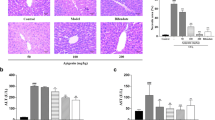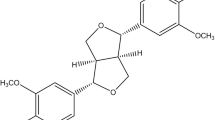Abstract
Purpose
The aim of this study was to evaluate the effect of inflammation on NAD(P)H: quinone oxidoreductase-1 (NQO1), the xenobiotic metabolizing and antioxidant enzyme protecting cells against electrophiles and reactive oxygen species in biliary cancer (cholangiocarcinoma) cells.
Methods
Human cholangiocarcinoma cell line, KKU-OCA17 and HeLa Chang liver cells were treated with inflammatory cytokine combinations (interferon-γ, interleukin-1β and tumor necrosis factor-α) for 48 h before NQO1 activity was assayed. Oxidant status was examined by assays of formation of nitric oxide (NO) and superoxide, and glutathione (GSH) levels. Expression of NQO1 was assessed by a reverse transcription and polymerase chain reaction. Effects of S-nitroso-glutathione (GSNO) were examined if the effects of inflammatory cytokines could be mimicked by nitric oxide donor.
Results
NQO1 activity in KKU-OCA17 and HeLa Chang liver cells was suppressed by cytokine combination. Cytokines induced formation of NO and suppression of redox ratios of GSH and glutathione disulfide (GSSG). GSNO produced the similar effects as cytokines on KKU-OCA17, in contrast, GSNO induced increase of NQO1 activity in HeLa Chang liver cells. The treatment of cytokines or GSNO suppressed expression of NQO1 in KKU-OCA17 and HeLa Chang liver cells.
Conclusions
Inflammatory cytokines induced oxidative stress and this is associated with suppression of NQO1, whereas may contribute to differential susceptibility of biliary epithelial cells to chemical-induced cytotoxicity and carcinogenesis.




Similar content being viewed by others
References
Asher G, Lotem J, Kama R, Sachs L, Shaul Y (2002) NQO1 stabilizes p53 through a distinct pathway. Proc Natl Acad Sci USA 99:3099–3104. doi:10.1073/pnas.052706799
Asher G, Tsvetkov P, Kahana C, Shaul Y (2005) A mechanism of ubiquitin-independent proteasomal degradation of the tumor suppressor’s p53 and p73. Genes Dev 19:316–321. doi:10.1101/gad.319905
Brunmark A, Cadenas E, Segura-Aguilar J, Lind C, Ernster L (1988) DT-diaphorase-catalyzed two-electron reduction of various p-benzoquinone- and 1, 4-naphthoquinone epoxides. Free Radic Biol Med 5:133–143. doi:10.1016/0891-5849(88)90076-7
Buranrat B, Prawan A, Sripa B, Kukongviriyapan V (2007) Inflammatory cytokines suppress arylamine N-acetyltransferase 1 in cholangiocarcinoma cells. World J Gastroenterol 13:6219–6225. doi:10.3748/wjg.13.6219
Cathcart MK (2004) Regulation of superoxide anion production by NADPH oxidase in monocytes/macrophages: contributions to atherosclerosis. Arterioscler Thromb Vasc Biol 24:23–28. doi:10.1161/01.ATV.0000097769.47306.12
Dhakshinamoorthy S, Jaiswal AK (2000) Small maf (MafG and MafK) proteins negatively regulate antioxidant response element-mediated expression and antioxidant induction of the NAD(P)H:Quinone oxidoreductase1 gene. J Biol Chem 275:40134–40141. doi:10.1074/jbc.M003531200
Dinkova-Kostova AT, Talalay P (2000) Persuasive evidence that quinone reductase type 1 (DT diaphorase) protects cells against the toxicity of electrophiles and reactive forms of oxygen. Free Radic Biol Med 29:231–240. doi:10.1016/S0891-5849(00)00300-2
Gao J, Kashfi K, Liu X, Rigas B (2006) NO-donating aspirin induces phase II enzymes in vitro and in vivo. Carcinogenesis 27:803–810. doi:10.1093/carcin/bgi262
Gharavi N, El-Kadi AO (2007) Role of nitric oxide in downregulation of cytochrome P450 1a1 and NADPH: quinone oxidoreductase 1 by tumor necrosis factor-alpha and lipopolysaccharide. J Pharm Sci 96:2795–2807. doi:10.1002/jps.20910
Hancock JT, Desikan R, Neill SJ (2001) Role of reactive oxygen species in cell signalling pathways. Biochem Soc Trans 29:345–350. doi:10.1042/BST0290345
Hensley K, Robinson KA, Gabbita SP, Salsman S, Floyd RA (2000) Reactive oxygen species, cell signaling, and cell injury. Free Radic Biol Med 28:1456–1462. doi:10.1016/S0891-5849(00)00252-5
RC IA (1994) Infection with liver flukes (Opisthorchis viverrini, Opisthorchis felineus and Clonorchis sinensis). IARC Monogr Eval Carcinog Risks Hum 61:121–175
Ishikawa M, Numazawa S, Yoshida T (2005) Redox regulation of the transcriptional repressor Bach1. Free Radic Biol Med 38:1344–1352. doi:10.1016/j.freeradbiomed.2005.01.021
Jain AK, Jaiswal AK (2007) GSK-3beta acts upstream of Fyn kinase in regulation of nuclear export and degradation of NF-E2 related factor 2. J Biol Chem 282:16502–16510. doi:10.1074/jbc.M611336200
Jaiswal M, LaRusso NF, Shapiro RA, Billiar TR, Gores GJ (2001) Nitric oxide-mediated inhibition of DNA repair potentiates oxidative DNA damage in cholangiocytes. Gastroenterology 120:190–199. doi:10.1053/gast.2001.20875
Joseph P, Jaiswal AK (1994) NAD(P)H:quinone oxidoreductase1 (DT diaphorase) specifically prevents the formation of benzo[a]pyrene quinone-DNA adducts generated by cytochrome P4501A1 and P450 reductase. Proc Natl Acad Sci USA 91:8413–8417. doi:10.1073/pnas.91.18.8413
Kawanishi S, Hiraku Y, Pinlaor S, Ma N (2006) Oxidative and nitrative DNA damage in animals and patients with inflammatory diseases in relation to inflammation-related carcinogenesis. Biol Chem 387:365–372. doi:10.1515/BC.2006.049
Kiyohara C, Yoshimasu K, Takayama K, Nakanishi Y (2005) NQO1, MPO, and the risk of lung cancer: a HuGE review. Genet Med 7:463–478. doi:10.1097/01.gim.0000177530.55043.c1
Kobayashi A, Kang MI, Okawa H, Ohtsuji M, Zenke Y, Chiba T et al (2004) Oxidative stress sensor Keap1 functions as an adaptor for Cul3-based E3 ligase to regulate proteasomal degradation of Nrf2. Mol Cell Biol 24:7130–7139. doi:10.1128/MCB.24.16.7130-7139.2004
Lind C, Cadenas E, Hochstein P, Ernster L (1990) DT-diaphorase: purification, properties, and function. Methods Enzymol 186:287–301. doi:10.1016/0076-6879(90)86122-C
Nioi P, Hayes JD (2004) Contribution of NAD(P)H:quinone oxidoreductase 1 to protection against carcinogenesis, and regulation of its gene by the Nrf2 basic-region leucine zipper and the arylhydrocarbon receptor basic helix-loop-helix transcription factors. Mutat Res 555:149–171. doi:10.1016/j.mrfmmm.2004.05.023
Ohshima H, Tazawa H, Sylla BS, Sawa T (2005) Prevention of human cancer by modulation of chronic inflammatory processes. Mutat Res 591:110–122. doi:10.1016/j.mrfmmm.2005.03.030
Parsons JK, Nelson CP, Gage WR, Nelson WG, Kensler TW, De Marzo AM (2001) GSTA1 expression in normal, preneoplastic, and neoplastic human prostate tissue. Prostate 49:30–37. doi:10.1002/pros.1115
Pinlaor S, Hiraku Y, Ma N, Yongvanit P, Semba R, Oikawa S et al (2004) Mechanism of NO-mediated oxidative and nitrative DNA damage in hamsters infected with Opisthorchis viverrini: a model of inflammation-mediated carcinogenesis. Nitric Oxide 11:175–183. doi:10.1016/j.niox.2004.08.004
Prochaska HJ, Santamaria AB (1988) Direct measurement of NAD(P)H:quinone reductase from cells cultured in microtiter wells: a screening assay for anticarcinogenic enzyme inducers. Anal Biochem 169:328–336. doi:10.1016/0003-2697(88)90292-8
Radjendirane V, Joseph P, Lee YH, Kimura S, Klein-Szanto AJ, Gonzalez FJ et al (1998) Disruption of the DT diaphorase (NQO1) gene in mice leads to increased menadione toxicity. J Biol Chem 273:7382–7389. doi:10.1074/jbc.273.13.7382
Richardson TA, Morgan ET (2005) Hepatic cytochrome P450 gene regulation during endotoxin-induced inflammation in nuclear receptor knockout mice. J Pharmacol Exp Ther 314:703–709. doi:10.1124/jpet.105.085456
Saldivar SJ, Wang Y, Zhao H, Shao L, Lin J, Spitz MR et al (2005) An association between a NQO1 genetic polymorphism and risk of lung cancer. Mutat Res 582:71–78
Schafer FQ, Buettner GR (2001) Redox environment of the cell as viewed through the redox state of the glutathione disulfide/glutathione couple. Free Radic Biol Med 30:1191–1212. doi:10.1016/S0891-5849(01)00480-4
Siegel D, Bolton EM, Burr JA, Liebler DC, Ross D (1997) The reduction of alpha-tocopherolquinone by human NAD(P)H: quinone oxidoreductase: the role of alpha-tocopherolhydroquinone as a cellular antioxidant. Mol Pharmacol 52:300–305
Siegel D, Gustafson DL, Dehn DL, Han JY, Boonchoong P, Berliner LJ et al (2004) NAD(P)H:quinone oxidoreductase 1: role as a superoxide scavenger. Mol Pharmacol 65:1238–1247. doi:10.1124/mol.65.5.1238
Somparn N, Kukongviriyapan U, Tassaneeyakul W, Jetsrisuparb A, Kukongviriyapan V (2007) Modification of CYP2E1 and CYP3A4 activities in haemoglobin E-beta thalassemia patients. Eur J Clin Pharmacol 63:43–50. doi:10.1007/s00228-006-0224-x
Spirli C, Fabris L, Duner E, Fiorotto R, Ballardini G, Roskams T et al (2003) Cytokine-stimulated nitric oxide production inhibits adenylyl cyclase and cAMP-dependent secretion in cholangiocytes. Gastroenterology 124:737–753. doi:10.1053/gast.2003.50100
Sriplung H, Wiangnon S, Sontipong S, Sumitsawan Y, Martin N (2006) Cancer incidence trends in Thailand, 1989–2000. Asian Pac J Cancer Prev 7:239–244
Srivatanakul P, Ohshima H, Khlat M, Parkin M, Sukarayodhin S, Brouet I et al. (1991) Endogenous nitrosamines and liver fluke as risk factors for cholangiocarcinoma in Thailand. IARC Sci Publ 88–95
Thamavit W, Bhamarapravati N, Sahaphong S, Vajrasthira S, Angsubhakorn S (1978) Effects of dimethylnitrosamine on induction of cholangiocarcinoma in Opisthorchis viverrini-infected Syrian golden hamsters. Cancer Res 38:4634–4639
Trachootham D, Lu W, Ogasawara MA, Nilsa RD, Huang P (2008) Redox regulation of cell survival. Antioxid Redox Signal 10:1343–1374. doi:10.1089/ars.2007.1957
Acknowledgments
This work was supported by the Thailand Research Fund (TRF), National Science and Technology Development Agency (NSTDA) and Grant-in-aid from Khon Kaen University. Benjaporn Buranrat is supported by a scholarship from the Commission on Higher Education, the Ministry of Education, and the Liver Fluke and Cholangiocarcinoma Research Center, Khon Kaen University.
Author information
Authors and Affiliations
Corresponding author
Rights and permissions
About this article
Cite this article
Prawan, A., Buranrat, B., Kukongviriyapan, U. et al. Inflammatory cytokines suppress NAD(P)H:quinone oxidoreductase-1 and induce oxidative stress in cholangiocarcinoma cells. J Cancer Res Clin Oncol 135, 515–522 (2009). https://doi.org/10.1007/s00432-008-0483-2
Received:
Accepted:
Published:
Issue Date:
DOI: https://doi.org/10.1007/s00432-008-0483-2




